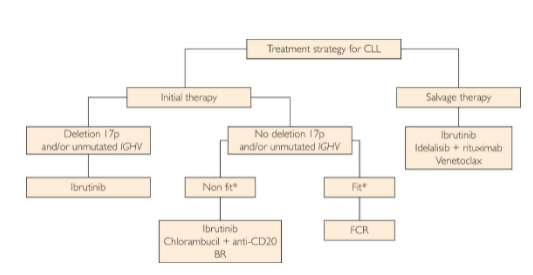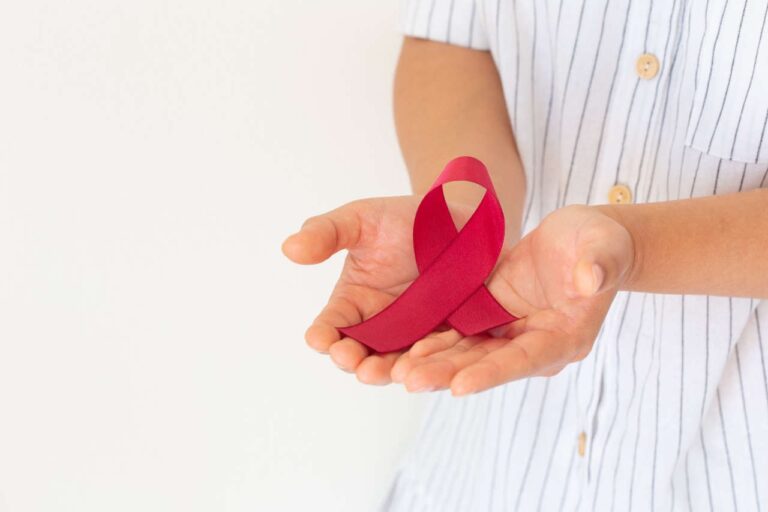
Chronic lymphocytic leukemia (CLL) is a cancer of the blood and bone marrow cells that generally develops gradually. CLL is one of the most common types of cancer in adults. It usually occurs after adulthood, and its prevalence is rare in children.
The bone marrow is a spongy tissue present in the bones that contain the stem cells, which produce the blood cells. A stem cell may develop into a myeloid stem cell or a lymphoid stem cell.
Get IVIG Copay Assistance
Speak to a SpecialistA myeloid stem cell may give rise to the following three different types of blood cells.
- Red blood cells (erythrocytes) that transport oxygen and nutrients to the body
- White blood cells (lymphocytes) that develop the immune system of the body
- Platelets (thrombocytes), which are responsible for blood clots to stop bleeding
A lymphoid stem cell matures into any of the three types of lymphocytes (white blood cells):
- B lymphocytes, which are responsible for the development of antibodies
- T lymphocytes that help B lymphocytes develop antibodies
- Natural killer cells (NKC) that fight cancer cells and viruses
In CLL, many lymphocytes turn into abnormal cells called leukemia cells, which are not able to fight infection effectively. As the number of leukemia cells increases, the number of normal blood cells decreases [1].
CLL Causes and Risk Factors
In the United States, more than 20,000 new cases of CLL occur every year. CLL is one of the most common types of leukemia in adults. It accounts for about 1 in 4 new leukemia cases. Its prevalence is more frequent after the age of 60 and very rare before the age of 40.
The cause of CLL is still unknown. There is no strong relationship between radiation, infections, diet, and CLL.
The following are the risks factors for CLL:
- Age: CLL is more prevalent in the elderly.
- Race: White people are at more risk than others.
- Family history: A family history of CLL may increase risk.
- Chemical exposure: Certain chemicals increase the risk of CLL (e.g., herbicides, insecticides).
Treatment Info
Get IVIG Prior AuthorizationSymptoms of CLL
Initially, CLL has no symptoms, but symptoms begin to appear as the disease progresses. The following are the most common symptoms that may occur in CLL patients:
- Enlarged lymph nodes
- Frequent infections
- Unexplained weight loss
- Weakness/feeling tired
- Body pain
- Night sweats
- Anemia
- High temperature
Diagnosis
If a patient has any of the symptoms listed above, it is important to get screened for CLL. This can involve blood tests, x-rays, and scans that can lead to a proper diagnosis.
A few of the tests that you may have to undergo are:
- Blood tests to determine the number and shapes of different blood cells.
- X-rays and scans to evaluate swollen lymph nodes and spleen.
- Bone marrow biopsy to determine the presence of CLL cells.
- Lymph node biopsy to determine if the lymph node contains cancer cells.
- Mutation tests to evaluate genetic mutation by taking samples of bone marrow.
Life Expectancy in Patients With CLL
Life expectancy varies from patient to patient, and it also depends upon the time of diagnosis. Some patients die 2 to 3 years after the diagnosis because of complications. Others may live for 5 to 10 years from initial diagnosis with proper treatment.
- About 80% of the patients aged 15-64 survive for 5 years or more after diagnosis.
- About 60% of patients aged 65 or older survive for 5 years or more after diagnosis.
Generally, 70% of males and 75% of females affected with CLL survive for 5 years or more after diagnosis [4].
Get IVIG Copay Assistance
IVIG Financial AssistanceTreatment Options for CLL
Chronic lymphocytic leukemia [2] is curable, but the recovery rate is very small. A patient with CLL can live for years, but it is very rare for a patient to fully recover and be free from any type of lymphoma or leukemia.
Treatment of CLL depends on many factors such as the stage at which it is diagnosed, the presence of symptoms and their severity, general health condition, and age.
If the patient is not experiencing any signs or symptoms, there is no need for treatment as studies have shown that treatment at this stage does not increase life expectancy and produces many side effects.
If your doctor suggests that your CLL requires treatment, you may have the following options [5]:
Watchful Waiting
Watchful waiting is closely monitoring the patient’s health without administering any drug or medication. This therapy is used in asymptomatic patients at the early stage of CLL. This is also called observation.
Chemotherapy
Chemotherapy is a drug treatment that kills quickly growing cells, including cancer cells. Chemotherapy treatments can be administered through a vein or taken in pill form. Cyclophosphamide is an alkylating agent used in the management of leukemia or other types of cancer. Cyclophosphamide binds with the DNA and stops the synthesis of proteins and hence blocks the cell’s abnormal growth, resulting in the death of cancer cells. Cyclophosphamide is usually used in combination with rituximab. Depending on your situation, your doctor may use a single chemotherapy drug, or you may receive a combination of drugs.
The medications used to treat CLL can cause some significant side effects, including:
- Continuous tiredness
- Feeling weak and sick
- Increased and frequent risk of infections
- Frequent bruising or bleeding
- Anemia – shortness of breath, weakness, and pale skin
- Hair loss or thinning
- Irregular heartbeat
Consult an IVIG Specialist
The Best IVIG Home Infusion | Get IVIG Treatment AssistanceRadiation Therapy
Radiation therapy is one of the cancer treatment options that uses high-energy x-rays or other types of radiation to kill cancer cells or prevent them from increasing. External radiation therapy uses a machine outside the body to send radiation toward the area of the body affected with CLL, such as a group of lymph nodes or the spleen. This treatment may be used to reduce pain related to a swollen spleen or lymph nodes.
Targeted Drug Therapy
Targeted drug treatments directly focus on specific abnormalities present within the body. By controlling these abnormalities, targeted drug treatments kill the CLL cells. This therapy usually has less harmful effects. Below are the different types of targeted drug therapy methods used to treat CLL. Most of the drugs of this group target the CD20 protein receptors of the cancerous cells.
- Tyrosine kinase inhibitor (TKI) therapy: This treatment inhibits the enzyme, tyrosine kinase, responsible for the conversion of stem cells into cancerous cells of CLL. Ibrutinib, acalabrutinib, idelalisib, and duvelisib are TKI drugs used to manage different types of CLL.
- BCL2 inhibitor therapy: These drugs block the protein called B-cell lymphoma 2 (BCL2), present on the CLL cells. Venetoclax, the first drug developed and approved by FDA in 2016, is a type of BCL2 therapy used to treat different types of CLL [6].
- Monoclonal antibodies: Monoclonal antibodies are proteins of the immune system developed in the lab to manage many disorders including CLL. In CLL, these drugs bind with the specific receptor on the CLL cells and block their growth. These drugs later kill the CLL cells. Different drugs are used in combination to treat CLL at different stages. The antibodies kill the cancer cells, block their growth, or keep them from spreading. These drugs are mostly given as an IV infusion. Different monoclonal antibodies used in the treatment of CLL are ibrutinib, rituximab, Rituxan, and venetoclax. Rituximab is one of the most prescribed monoclonal antibodies to treat CLL. Rituximab has a better efficacy and safety profile compared to other drugs, and it is mostly used in combination with other anticancer drugs. Almost all the monoclonal antibodies attack the CD20 receptors of the cancer cells.
Bone marrow transplant
In a bone marrow transplant (stem cell transplant), the abnormal and cancerous bone marrow of the patient is replaced with the healthy and normal bone marrow of the donor. Thus, the patient’s body starts producing healthy blood cells. However, this method is very costly and does not give effective and satisfactory outcomes.
Immunotherapy
Immunotherapy is the latest and most effective treatment option which uses the patient’s immune system to kill cancer cells. Immunotherapy helps the body fight CLL cells and supports the natural defense system of the body [7].
Get IVIG Copay Assistance
Your IVIG Treatment Info | Get IVIG Prior AuthorizationIVIG Therapy to Treat CLL
Most CLL patients don’t produce enough antibodies (immunoglobulins, or IgG) to combat infection. This results in frequent infections of the lungs and sinuses. Based on the signs, symptoms and their severity, a patient may start IVIG therapy.
The start of IVIG treatment varies from patient to patient, and from clinician to clinician. Some cancer centers, oncology hospitals, and oncologists wait for the IgG level to drop below a certain level. Other clinicians start IVIG with or without low IgG levels in the body to prevent further harmful effects of CLL. For the most part, IVIG therapy is administered once a month, initially. Its dose may be adjusted later according to the need of the patient.
Studies have proved that IVIG is very much effective in preventing infections in CLL patients. A meta-analysis conducted in 2009 found that while no survival benefit could be demonstrated, IVIG therapy led to a significant decrease in the development of major infections and a significant reduction in clinically documented infections.
Another crossover study found that low-dose IVIG therapy was just as effective as high-dose IVIG therapy.
Most Effective Treatment Plans for CLL
Treatment protocols may change with the stage and severity of cancer and the patient’s general physical health. Treatment options for high-risk patients are different from others.
Some different potential treatment plans are:
- Stem cell transplantation. This is an option if the physical health and fitness of the patient allow it.
- Alemtuzumab, a monoclonal antibody. Monotherapy of this drug proved very effective in more than 60% of the CLL patients. Its efficacy is proved in multiple studies.
- Ibrutinib (Imbruvica). This drug can be used as monotherapy or in combination with rituximab (Rituxan), which may be a better choice to treat lymphoma.
- Venetoclax (Venclexta). Venetoclax can be used as monotherapy or in combination with obinutuzumab (a monoclonal antibody), depending on the condition of the patient and the stage of cancer. Venetoclax is also used in combination with rituximab.
Many complications are associated with chemotherapy treatment and must be managed with an appropriate anticancer drug. Multiple other drugs are used in accordance with the complications of the patient.
Figure 2:
Treatment strategy flow chart for CLL. *Fit is defined in the United States as patients younger than 65 years and with good performance status. BR = bendamustine and rituximab. FCR = fludarabine, cyclophosphamide, and rituximab. IGHV = immunoglobulin heavy chain variable gene.

REFERENCES:
- Burger, J.A. Chemokines and chemokine receptors in chronic lymphocytic leukemia (CLL): from understanding the basics towards therapeutic targeting. in Seminars in cancer biology. 2010. Elsevier.
- https://www.cancer.gov/types/leukemia/patient/cll-treatment-pdq. 2021 [cited 2021 10-10-2021]; Available from: https://www.cancer.gov/types/leukemia/patient/cll-treatment-pdq.
- Matutes, E., et al., The immunological profile of B-cell disorders and proposal of a scoring system for the diagnosis of CLL. 1994. 8(10): p. 1640-1645.
- Delgado, J., et al., Chronic lymphocytic leukemia: a prognostic model comprising only two biomarkers (IGHV mutational status and FISH cytogenetics) separates patients with different outcome and simplifies the CLL‐IPI. 2017. 92(4): p. 375-380.
- Schiffer, C.A. and E.J.U.U. Atallah, Larson RA ed. UpToDate. Waltham, MA: UpToDate, Overview of the treatment of chronic myeloid leukemia. 2020.
- Whitaker, J.A., et al., The humoral immune response to high-dose influenza vaccine in persons with monoclonal B-cell lymphocytosis (MBL) and chronic lymphocytic leukemia (CLL). 2021. 39(7): p. 1122-1130.
- Logue, J.M., et al., Immune reconstitution and associated infections following axicabtagene ciloleucel in relapsed or refractory large B-cell lymphoma. 2021. 106(4): p. 978.
- Brem, E.A. and S. O’Brien, Frontline Management of CLL in 2021. JCO Oncology Practice, 2021: p. OP.21.00258.












